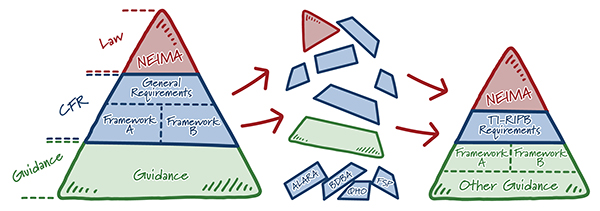Posted on March 16, 2023 by Nicholas McMurray
Pencils down! The Nuclear Regulatory Commission (NRC) staff just published its draft proposed rule for licensing advanced nuclear reactors — over 1,000 pages of draft text for the NRC Commissioners to review and vote on. If crafted well, the licensing process known as Part 53 has the potential to be a 21st Century solution for the next generation of reactors, laying the groundwork for the NRC to handle the anticipated wave of new reactor applications while meeting their safety and security mission.
While this was a significant effort by NRC staff on top of multiple ongoing license reviews, pre-application interactions, and other important rulemakings, the world looks much different than when the Nuclear Energy Innovation and Modernization Act (NEIMA) was enacted in January 2019 and the Part 53 rule development process started in November 2020. As the Commissioners review and vote on the draft proposed rule, they should keep in mind the significant support and funding that Congress has directed towards advanced reactors, and the bipartisan desire to enable the swift deployment of these designs to provide energy security and help address climate change.
In response to the January 2019 enactment of NEIMA, the staff put together a rulemaking plan, and began to implement an NRC Commission-directed, and Congress-supported, accelerated rulemaking timeline. From November 2020 through August 2022, the NRC staff received over 100 public comments and held over 30 public meetings. As the draft rule was being prepared, there was a significant number of detailed, comments submitted by ClearPath, other NGOs, advanced reactor developers, utilities, the public, and other stakeholders. This took an incredible amount of effort by all involved who attended public meetings, made presentations, and provided robust feedback to the NRC on how to craft the rule.
Since NEIMA, additional policies like the Energy Act of 2020, the bipartisan Infrastructure Investment and Jobs Act, and the recently enacted tax credits have catalyzed commercialization timelines and laid the groundwork for rapid deployment. In fact, the NRC anticipates at least 13 current and potential applications, and at least 6 potential operating licenses by 2027.
The principles of NEIMA are still valid. However, with the paradigm-shifting nature of recent events, what Part 53 needs to accomplish today is different than what was envisioned. As the NRC Commissioners look to vote on the draft proposed rule they must ensure that they are meeting the original Congressional intent in NEIMA, which is to accelerate the deployment of these reactors using a simplified regulatory framework, while incorporating new Congressional action and responding to changing world events. Unfortunately, the proposal sent to the Commission seems to have missed the mark.
The NRC Commissioners need to determine if the draft rule can account for this rapidly changing landscape and achieve these ambitious outcomes. Based on the current rule text and thoughtful comments from stakeholders and future licensees, the answer to these questions is no. The Commissioners should return the rule to the staff along with communicating any necessary schedule changes, resources needs, or legislative gaps to policymakers. The NRC must be prepared to safely and efficiently license reactors without imposing unnecessary regulatory, cost or timeliness burdens. Congress can also do its part by holding the Commission and its staff accountable for reviewing these designs in a prompt and effective manner consistent with the Agency’s safety mandate.
A rule that is not ready to handle hundreds of applications featuring diverse reactor designs will only set the NRC up for challenges and an inability to meet its mission. An ineffective Part 53 could squander a once-in-a-generation opportunity. The NRC is an important and necessary step for enabling the safe commercialization of nuclear energy. If the Commission is not responsive, then the burden on the NRC staff will be immense as they will be using rules, processes, and procedures that are neither designed nor optimized for the future nuclear industry.
Multi-year processes must be adaptive and a change now would still allow the rule to be completed by NEIMA’s original mandate of a 2027 deadline. Locking in overly complex language today will be harder to untangle and fix tomorrow. This would be a waste of time, effort and taxpayer resources if the overall result is a rule that no applicant will seek to use.
Restructuring the Rule for Broad Deployment

Of course, for its part, the industry will need to prove in the marketplace that it can deliver projects on time and on budget, enabling a rapid-scale buildout of nuclear energy. However, regardless of industry trends, the NRC’s role should be to proactively establish a framework to safely regulate the industry.
Now is the time to set down the pencils, take a few steps back, and consider if the draft rule meets the needs of today and tomorrow. That is the decision before the Commissioners today. The world is transformed, and the NRC has a key role to play in enabling the transformation of clean energy delivery through the additional deployment of nuclear technologies. As Chairman Hanson wrote in his vote approving the beginning of the Part 53 rulemaking, “speed should not take priority over a thoughtful rulemaking.” The status quo is not an option. Congress has made that clear, and bold Commission leadership is needed when considering the next steps of the Part 53 rulemaking.
